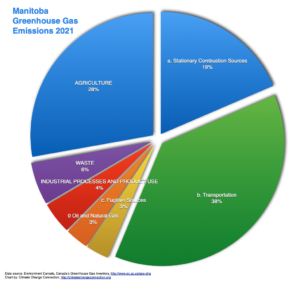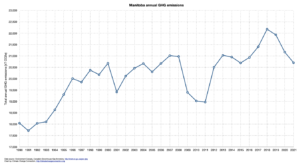 In this section, you will see Manitoba’s GHG emissions from various key sectors.
In this section, you will see Manitoba’s GHG emissions from various key sectors.
- Manitoba agricultural GHGs
- Manitoba Large Final Emitters (LFE)
- Manitoba stationary combustion
- Manitoba transportation GHGs
- Manitoba waste GHGs
![]() Click a topic to jump to a page with details.
Click a topic to jump to a page with details.
NOTE: All data in this section are in CO2 equivalent kilotonnes per year. (1 kilotonne = 1000 tonnes = 1 million kilograms)
In 2021
In 2021, Manitoba’s GHG emissions came from these sectors and in these proportions: (NOTE: These numbers may not add up correctly due to rounding.)
- 57% – Fossil fuel burning for the following purposes:
- 38% – Transportation – moving people and goods
- 19% – Stationary combustion – the energy used for residential and commercial heating, in electricity generation, in the oil and gas industry, and in the manufacturing and construction industries
- 28% – Agriculture – mostly methane (CH4) from livestock and nitrous oxide (N2O) from soils
- 6% – Waste disposal – mostly methane (CH4) from landfills
- 4% – Industrial processes
- 3% – Fugitive sources
- 3% – Oil & Natural Gas industry
(For data in an Excel spreadsheet click here: EN_GHG_IPCC_MB (416 KB)
(To download a printable PDF version click here: Manitoba_GHG_trend_data_1990-2021.pdf (91 KB)
Manitoba’s emissions from the energy (fossil fuel burning) category contributed about 60% of our GHG emissions. This is a much lower proportion than for Canada as a whole. (1) The key reason for this is that Manitoba’s electricity is produced from hydropower. Consequently, we have a higher proportionate GHG contibution from agriculture than any other province.
1990 to 2021 trend and targets
Overall, Manitoba’s GHG emissions in 2021 were 14.7% higher than in 1990.
Also, our emissions were 22% above the level we should have been at by 2012 to achieve our Kyoto Protocol target.
Note the emissions dropped from 2009 to 2011. This drop may have been due to trends in economic activity due to the 2008 recession.
Emissions in 2018 were at an all-time high.
The impacts of COVID-19 influenced the emissions drop in 2020, especially in transportation.






